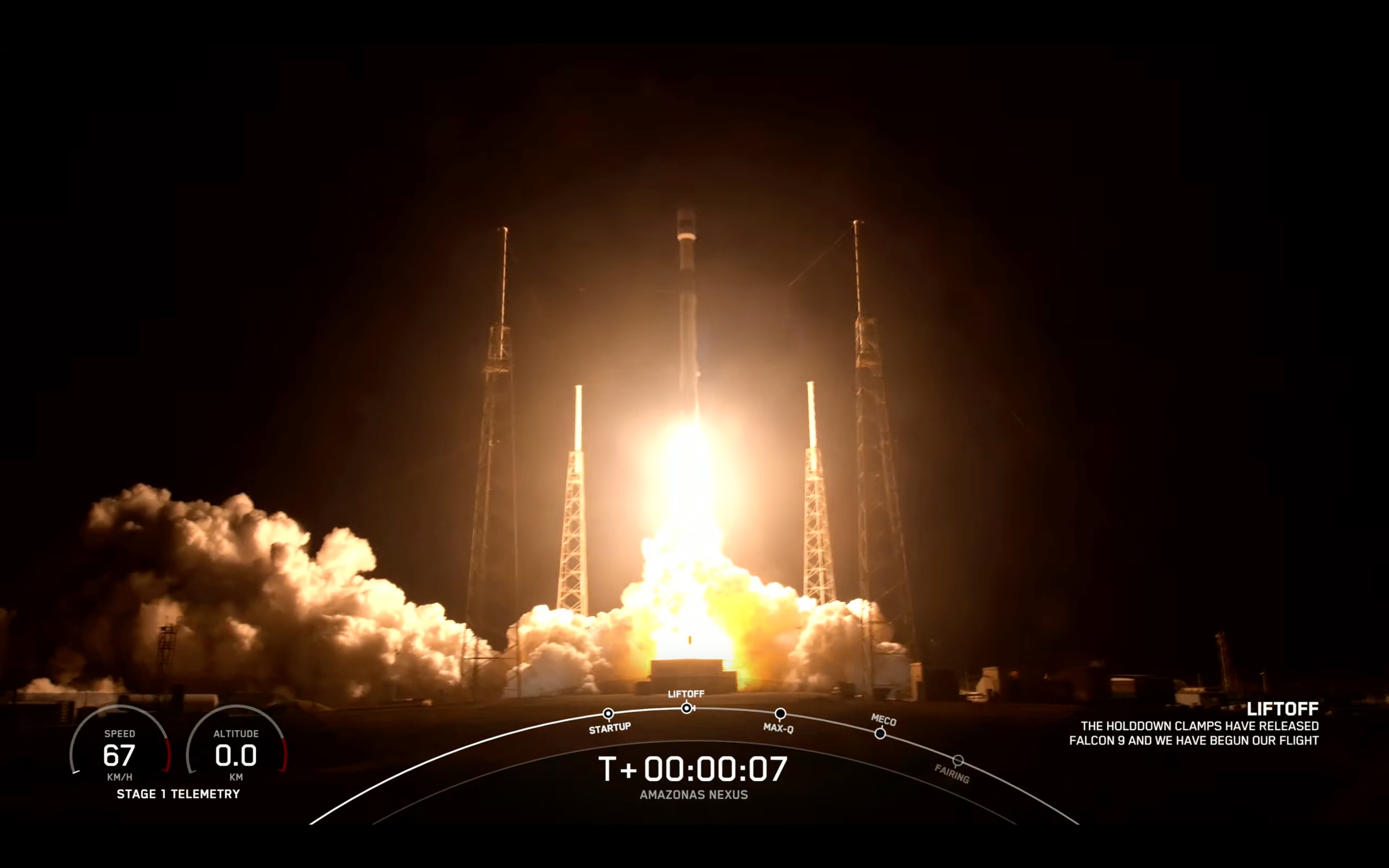SpaceX launches huge communications satellite, lands rocket at sea
SpaceX launched a commercial communications satellite to orbit on Monday (Feb. 6) and landed a rocket on a ship at sea.
A Falcon 9 rocket carrying the Amazonas Nexus satellite for the Spanish company Hispasat lifted off from Cape Canaveral Space Force Station in Florida on Monday at 8:32 p.m. EST (0332 GMT on Feb. 7).
The Falcon 9's first stage came back to Earth for a vertical touchdown 8.5 minutes after liftoff as planned. The landing occurred on the SpaceX droneship Just Read the Instructions, which was stationed in the Atlantic Ocean a few hundred miles off the Florida coast.
Related: 8 ways that SpaceX has transformed spaceflight
It was the sixth liftoff and landing for this particular booster, according to a SpaceX mission description. The rocket also lofted the SES-22 communications satellite, the Hakuto-R moon lander for Tokyo-based company ispace and three batches of SpaceX's Starlink internet satellites.
The landing was also the 170th overall for SpaceX during an orbital mission, counting those of both the Falcon 9 and the company's powerful Falcon Heavy launcher.
The Falcon 9's upper stage continued carrying Amazonas Nexus skyward on Monday, eventually deploying the 10,000-pound (4,500 kilograms) satellite into geostationary transfer orbit just under 36 minutes after liftoff as planned.
Breaking space news, the latest updates on rocket launches, skywatching events and more!
Amazonas Nexus will now spend more than six months making its way to geostationary orbit, about 22,200 miles (35,700 kilometers) above Earth. Hispasat will perform a few weeks of checkouts with the spacecraft, then slip it into its final orbit and put the satellite to work providing internet service to broad swathes of the globe for at least the next 15 years.
Amazonas Nexus "will cover the entire American continent, Greenland and the North and South Atlantic corridors and will be focused on connectivity services in remote areas and in air and maritime mobility environments," Hispasat wrote in a prelaunch statement.
Shortly after Amazonas Nexus was deployed, the U.S. Space Force revealed that it has a payload integrated into the satellite — a "high-bandwidth protected communications transponder" manifested as part of the military's Pathfinder 2 mission.
"The goal of the Pathfinder series is to demonstrate affordable bandwidth acquisition by gaining long-term access to transponder assets from commercial satellite providers," Space Force officials wrote in an emailed statement.
"Pathfinder 2 will improve the diversity, flexibility and resiliency of the U.S. Space Force's satellite communication architecture and provide increased capability to the warfighter," they added. "This mission utilizes existing commercial technologies to demonstrate innovative, affordable and resilient wideband alternative satellite communications."
Monday's launch had been targeted for Sunday (Feb. 5), but SpaceX called that attempt off due to bad weather. The liftoff was SpaceX's ninth already of 2023, keeping the company on pace to break its single-year launch record of 61, set in 2022.
Editor's note: This story was updated at 3 p.m. ET on Feb. 5 with the new launch target time of 7:32 p.m. EST and the updated weather forecast, then again at 6:20 p.m. ET with news of the delay to Feb. 6. It was updated again at 5:10 p.m. ET on Feb. 6 with the new launch time of 8:32 p.m. EST, then again at 9:15 p.m. EST with news of successful launch, rocket landing and satellite deployment, then again at 9:30 p.m. EST with news of the U.S. Space Force payload flying on Amazonas Nexus.
Mike Wall is the author of "Out There" (Grand Central Publishing, 2018; illustrated by Karl Tate), a book about the search for alien life. Follow him on Twitter @michaeldwall. Follow us on Twitter @Spacedotcom or Facebook.

Michael Wall is a Senior Space Writer with Space.com and joined the team in 2010. He primarily covers exoplanets, spaceflight and military space, but has been known to dabble in the space art beat. His book about the search for alien life, "Out There," was published on Nov. 13, 2018. Before becoming a science writer, Michael worked as a herpetologist and wildlife biologist. He has a Ph.D. in evolutionary biology from the University of Sydney, Australia, a bachelor's degree from the University of Arizona, and a graduate certificate in science writing from the University of California, Santa Cruz. To find out what his latest project is, you can follow Michael on Twitter.


